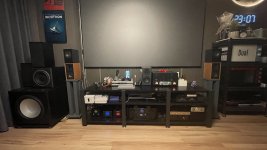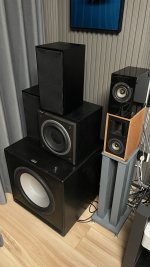@stv I don't disagree with that. I'm just saying the relative net effect is negligible.
Please read my post(s) again. I'm qualifying my statements very clearly.
Plus, I did some actual practical tests to look at this closely.
I have the plots here on my computer somewhere, but can't seem to find them right now.
Dave.
Please read my post(s) again. I'm qualifying my statements very clearly.
Plus, I did some actual practical tests to look at this closely.
I have the plots here on my computer somewhere, but can't seem to find them right now.
Dave.
I'm just saying the relative net effect is negligible.
With respect, I must push back on that just a little bit... It may have been negligible for the specific case you investigated, but that does not mean it will be negligible for all drivers in all cases.
Whether some distortion or other sonic phenomenon is negligible is a judgment call. There is frightfully little blind testing data on what kinds of distortions and other phenomena are perceptible during music playback. We must rely on our judgement, and thus we will all make a different decision.
@lrisbo and friends at Purifi have presented a passive notch filter method which reduces distortion, and with this class of very low distortion drivers, this approach makes good sense. It preserves the very low distortion performance of this rather expensive driver. If a person does not believe that distortion is audible below 1%, that person will not be buying Purifi drivers, so it is moot.
j.
the effect is actual, measurable and explained by theory. Also shown for non Purifi drivers by independent DIY’ers
@lrisbo Unfortunately, the measurements portion of your paper doesn't show the case I'm talking about here........which is to filter at line-level, before the power amplifier. I think, just as a point of reference, that might have interesting to include in your paper.
Anyways, I realize that implementation would be limited to multi-amp systems that already have the system crossover at line level. And, would most likely not work with conventional speaker systems that utilize a single amplifier and passive, high-level crossover.
In fact, I formulated/recommended an LCR filter for this exact use case for the LX521 speaker system. Owners updating to the magnesium driver offered by LinkwitzLab found themselves in this quandry, and an added passive, LCR notch filter to the midrange channel is the optimum solution.
Dave.
Anyways, I realize that implementation would be limited to multi-amp systems that already have the system crossover at line level. And, would most likely not work with conventional speaker systems that utilize a single amplifier and passive, high-level crossover.
In fact, I formulated/recommended an LCR filter for this exact use case for the LX521 speaker system. Owners updating to the magnesium driver offered by LinkwitzLab found themselves in this quandry, and an added passive, LCR notch filter to the midrange channel is the optimum solution.
Dave.
Last edited:
yes, comparison with the line level case is great. One of the admins of the DIY Loudspeaker PAD group on facebook did this and posted. There was a link in another thread here.
Yes they actually do.Unfortunately, the measurements portion of your paper doesn't show the case I'm talking about here........which is to filter at line-level, before the power amplifier. I think, just as a point of reference, that might have interesting to include in your paper.
Filtering at line level is the same thing as an analog active filter.
Which is the same as a DSP.
The way it's being done at line-level is 100% irrelevant.
Which should be also totally obvious if you understand the underlying principles behind this whole trick, since it involves the impedance seen by the back EMF.
It has been shown by multiple people now at different posts and topics, that filtering at line level (either by active/passive analog filter or DSP), does not do the same thing.
In this case I would recommend getting familiar with all of this, otherwise it's repeating the same discussion over an over again.
Davey! The source of the problem is not the breakup peak in the frequency response but the related harmonics. If you want the best possible solution for a problem, go to the source of it.
A line level filter can slightly reduce the harmonics by taming the frequency response peak relative to the other frequencies, but a proper speaker level series filter (which do increase the impedance between the amp and the speaker) can reduce it significantly more.
A line level filter can slightly reduce the harmonics by taming the frequency response peak relative to the other frequencies, but a proper speaker level series filter (which do increase the impedance between the amp and the speaker) can reduce it significantly more.
A driver looking back into a near-zero impedance has some distinct advantages as well.
I suggest to everybody to not ignore the larger picture here regards trade-offs.
Dave.
I suggest to everybody to not ignore the larger picture here regards trade-offs.
Dave.
I would suggest to everybody to perform an actual experiment, like I did.
I used a Seas L22 driver driven full range with just an LCR notch filter for the 4.2khz resonance. (While doing this, I measured the actual electrical drive seen by the L22.)
I then exactly duplicated that with my DSP crossover and removed the LCR filter and performed the distortion test again.
You might be surprised at the results. 🙂
Dave.
I used a Seas L22 driver driven full range with just an LCR notch filter for the 4.2khz resonance. (While doing this, I measured the actual electrical drive seen by the L22.)
I then exactly duplicated that with my DSP crossover and removed the LCR filter and performed the distortion test again.
You might be surprised at the results. 🙂
Dave.
Please describe your LCR filter exactly! If it was parallel with the driver, then it doesn't work like when it is connected in series with the driver.
I totally agree. I currently use two subwoofers (one 15-inch and one 10-inch) to take care of sounds below 150HZ, and the others use small bookshelf boxes with my Marantz8805 preamplifier for low-frequency management. The advantage of this is that it can Get very good mid- and high-frequency imaging and positioning, and very easy replacement of bookshelf speakers.My approach to combining active and passive crossover has been sorted out decades ago. I selected 150Hz as crossover point between woofers (two, not one sub) and two mid-tweeter boxes. Hence i have many active crossovers set at 150Hz.
Then i build many midweeter sections, easily swapable on top of the woofers, optimized with their own passive crossover. I use biamping, so difference in sensitivity between woofers and mid-tweeters is no issue. Other advantage is that small wattage amps are enough for top. Another advantage is no need to have way to many bulky floorstanding speakers around to clutter. Its easier to build and store mid-tweeters (bookshelfs).
Attachments
Yes, eventually, for some frequencies.driver looking back into a near-zero impedance has some distinct advantages
But it can also be the reason for distorsion, depending on the driver itself.
That is also the reason that for some drivers in some frequency ranges current drive (high impedance amp output) can lower distorsion.
I know it can be frustrating when you can't seem to get your point across.@YSDR WTF are we talking about here? Of course it was a series filter! That's the whole premise of Lars' paper.
I feel like I'm talking to juveniles here.
Keep in mind that you are presenting a hypothesis which goes against the conventionally accepted knowledge. That does not mean you are wrong, and contrarian views are sometimes correct while conventional wisdom is flawed. Regardless, when we present a novel or contrarian hypothesis, people will expect us to back up our claims with some evidence. The burden of evidence is on the one making the claim.
When someone asks us for details about our experiment, they are not insulting us, or accusing us of anything. It is just good standard practice, due diligence, basic scientific method...
@hifijim I made no contrarian claim the LCR series notch filter approach advocated by Lars doesn't reduce distortion exactly as claimed. In fact, I confirmed that it does. 🙂
If your attempt is to label me as contrarian, you are quite incorrect. Resorting to mischaracterizing what I've said is pretty silly.
One wonders if you are actually reading/comprehending my posts????
One thing about my posts here on DIYaudio is they are both commentary on the topic, but also a test (and I do this on purpose) to see if people are actually reading them fully.
That second part seems to trip people up quite a bit. There's a lot (too much) reading between the lines that happens on forums like this.
Anyways, over and out gents. Have a nice day.
Dave.
If your attempt is to label me as contrarian, you are quite incorrect. Resorting to mischaracterizing what I've said is pretty silly.
One wonders if you are actually reading/comprehending my posts????
One thing about my posts here on DIYaudio is they are both commentary on the topic, but also a test (and I do this on purpose) to see if people are actually reading them fully.
That second part seems to trip people up quite a bit. There's a lot (too much) reading between the lines that happens on forums like this.
Anyways, over and out gents. Have a nice day.
Dave.
Last edited:
I was not labeling you a contrarian. I admit I don't understand exactly the point you are trying to make regarding a series LCR filter in an active speaker application. You seem to be disputing the Purifi white paper, not by claiming it is wrong, but by claiming the distortion reduction is insignificant. But maybe I don't understand your point. For my benefit, could you restate your position?
I hope you continue to participate in this thread. I would like to see the Seas L22 data you collected.
"tone of voice" in your writing affects how I perceive your communication.
When there is a breakdown in communication, it is not solely for fault of the listener... the speaker bears some responsibility... yes?
j.
I hope you continue to participate in this thread. I would like to see the Seas L22 data you collected.
I read them at least three times, and I still am not exactly sure what you are getting at. The factual statements you make say one thing, but the aggressive and hostile language implies something else. YourOne thing about my posts here on DIYaudio is they are both commentary on the topic, but also a test (and I do this on purpose) to see if people are actually reading them fully.
"tone of voice" in your writing affects how I perceive your communication.
When there is a breakdown in communication, it is not solely for fault of the listener... the speaker bears some responsibility... yes?
j.
- Home
- Loudspeakers
- Multi-Way
- Combine passive and active crossover for better sound

